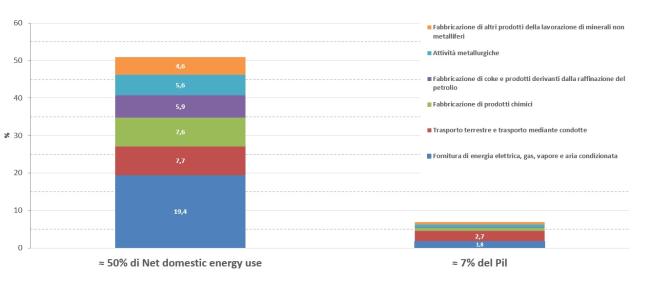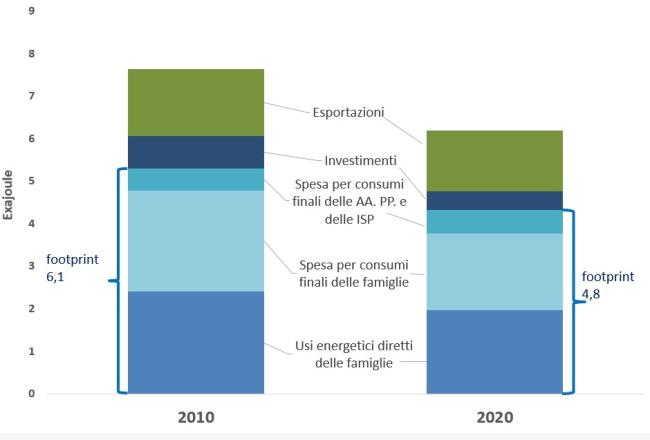Panel 1
Renato Marra Campanale
An economic system operates through energy inputs. The total energy consumption of resident units indicates the amount of energy used by economic activities and households for production and consumption activities, distinguishing energy uses from non-energy uses.
In 2021, the total energy consumption in Italy amounted to 7.05 exajoules, a 17.1% reduction compared to 2008. The total consumption is almost entirely for energy uses. In 2021, over two-thirds of the total energy use is attributable to productive activities. Among these, the top six activities for energy use (slightly more than half of total use) contribute to nearly 7% of Italy's Gross Domestic Product. 31% of the total energy use is due to household consumption (mainly heating/cooling and transport).
ISPRA also estimates the internal energy footprint, which allows the analysis of energy uses from the perspective of final domestic demand, highlighting the direct and indirect energy amounts embedded in the goods and services offered on the domestic market by Italian production chains.
The physical energy flow accounts (PEFA) account for the flows of energy in terajoules from the environment to the economy (natural energy inputs, such as fossil fuels—solids, liquids, and gases), within the economy (energy products, such as products from refineries and energy production plants), and from the economy back to the environment (residues, i.e., energy losses and other energy-related residues). These energy data conceptually belong to the environmental-economic accounting system. They are produced in line with the principles, definitions, and classifications of national economic accounts, making them ready for integrated analysis with environmental and economic data. PEFA data complement energy statistics derived from national energy balances. Their characteristics can be summarized in the following concepts, consistent with national economic accounts and the international statistical standard “System of Environmental-Economic Accounting - Central Framework” (SEEA-CF): the three types of energy flows (inputs, products, and residues); the accounting framework of the tables of resources and uses of these flows in physical terms; the principle of residency, i.e., accounting for energy flows from activities of resident units, regardless of the territory where these flows occur.
The indicator "Total energy consumption of resident units" (“net domestic energy use”), derived from PEFA accounts, measures the amount of energy used by economic activities and households for production and consumption. It can be further broken down by distinguishing between energy and non-energy uses, such as the use of petroleum products for plastic production. The total energy consumption of resident units is comparable to the most relevant indicator in national energy statistics derived from national energy balances, the “Gross inland energy consumption” (GIEC). Note that GIEC includes energy uses for non-energy purposes, which is why this indicator includes that component as well. Finally, it is emphasized that the Total energy consumption of resident units is based on the principle of residency, while GIEC follows the territorial principle. In addition to the total energy consumption of resident units, and for a more complete assessment of the energy flows associated with the functioning of an economy, it is important to also consider indirect flows, through estimating the “embedded” energy uses in goods and services for final uses (consumption, investment, and exports). Speaking of these estimates is equivalent to discussing the “internal energy footprint” of an economic system (excluding exports). These estimates are derived from the application of the input-output economic model, and the resulting indicators are generally referred to as “demand-based” as they describe the phenomenon from the activation of final demand. Specifically, the model redistributes the energy uses of economic activities (direct uses) to the goods and services produced (direct and indirect uses). In other words, the results describe the amount of energy necessary along the production chain of goods and services produced for final uses, regardless of the economic activity where the energy use took place.
Indicators derived from the energy flow accounts, such as the Total energy consumption of resident units, offer a complementary view to energy statistics that originate from national energy balances. The "domestic energy footprint" indicator attributes direct and indirect energy resources to the final consumer used to produce goods and services. Such information can help policymakers prepare targeted policies for production chains.
Regulation (EU) No. 691/2011 on European Environmental Economic Accounts, as amended by Regulation (EU) No. 538/2014
Panel 2
- Manual of Physical Energy Flow Accounts. Eurostat, Luxembourg, 2014 (https://ec.europa.eu/eurostat/documents/1798247/6191537/PEFA-Manual-2014-v20140515.pdf); - System of Environmental-Economic Accounting 2012 - Central Framework. United Nations, New York, 2014 (https://seea.un.org/content/seea-central-framework)
Data quality assessment
EUROSTAT – Statistical Office of the European Communities; ISPRA – Italian National Institute for Environmental Protection and Research; ISTAT – Italian National Institute of Statistics
Istat: http://dati.istat.it/Index.aspx --> Conti nazionali --> Conti ambientali --> Conti dei Flussi fisici di energia
National
2008-2021
Indicator assessment
The indicator is derived from the physical energy flow accounts, built in accordance with the principles, concepts, definitions, and classifications of national economic accounts. For more information, you can refer to the following methodological manuals: Manual of Physical Energy Flow Accounts. Eurostat, Luxembourg, 2014 (https://ec.europa.eu/eurostat/documents/1798247/6191537/PEFA-Manual-2014-v20140515.pdf); System of Environmental-Economic Accounting 2012 - Central Framework. United Nations, New York, 2014 (https://seea.un.org/content/seea-central-framework).
In 2021, as in previous years, the total energy consumption of resident units (7.05 exajoules) is almost entirely directed toward energy uses (95.5%); the remaining part is allocated to non-energy uses (Tables 1, 2, 3).
The total energy consumption of resident units in Italy in 2021 decreased by 17.1% compared to 2008, indicating a positive trend (Table 1).
Data
Figure 2: Economic activities with the highest energy use and their contribution to GDP (percentage values). Italy, 2021
ISPRA elaboration on Istat data
Elaborations on Value Added at Current Prices and Total Energy Consumption of Resident Units (Net Domestic Energy Use)
Table 1: Total energy consumption of resident units. Italy, 2008-2021
Istat
Table 2: Total energy consumption (energy uses) of resident units. Italy, 2008-2021
Istat
Table 3: Total energy consumption (non-energy uses) of resident units. Italy, 2008-2021
Istat
Table 4: Domestic energy footprint. Italy, 2020
Elaboration on Istat data
Domestic energy footprint refers to the energy used along the internal production chains of goods and services to meet domestic demand (final consumption and investments)



The total energy consumption of resident units (net domestic energy use) is almost entirely allocated to energy uses (over 95% throughout the period 2008-2021), with the remaining part directed to non-energy uses. Energy consumption can be further broken down into economic activities or household origins: in 2021, 69% of total energy uses come from productive activities (Table 1). In the same year, half of the total energy uses come from six activities (NACE classification: D - Electricity, gas, steam, and air conditioning supply; H49 - Land transport and transport via pipelines; C20 - Manufacture of chemicals; C19 - Manufacture of coke and refined petroleum products; C24 - Metallurgical activities; C23 - Manufacture of other non-metallic mineral products) contributing to almost 7% of Italy’s Gross Domestic Product (Table 1 and Figure 2).
In 2021, energy consumption for energy purposes (Table 2) is divided between economic activities (more than two-thirds) and households (around one-third). From 2008 to 2021, the consumption of the former decreased by 21%, while household consumption decreased by 8%. For economic activities, between 2008-2021, more than half of energy consumption comes from Manufacturing (C), Electricity, gas, steam, and air conditioning supply (D), and Transport and storage (H). It should be noted that the share of total manufacturing decreased by about 4 percentage points, from 28% in 2008 to 24% in 2021, along with a 30% reduction in total energy consumption for energy uses in this activity. Among manufacturing activities, about 60% of energy consumption over the entire period 2008-2021 comes from: Manufacture of coke and refined petroleum products (C19), Metallurgical activities (C24), Manufacture of other non-metallic mineral products (C23), and Manufacture of chemicals (C20). Household energy consumption for energy purposes is divided between heating/cooling, transport, and other uses: heating/cooling increases its share of total household consumption from 40% in 2008 to 53% in 2021; energy use for household transport decreased its share from 42% to 38%; other uses are characterized by two phases, with the 2013-2014 period being the dividing line, when it dropped from 19% of total consumption to 9% (Table 2).
Regarding consumption for non-energy purposes, the activity responsible for the manufacture of chemical products (C20) is the main contributor, with an average share of over 60% of the total from 2008 to 2021 (Table 3).
The internal energy footprint (excluding imports) for total energy uses allows the analysis of energy use from the final domestic demand side, regardless of foreign energy contributions (Figure 3 and Table 4). The estimates show a reallocation of the total amount from a production perspective to the categories of final internal uses (final consumption, investment), excluding foreign demand (i.e., exports): the results amount to 6.1 exajoules in 2010 and 4.8 exajoules in 2020 (Figure 3).
Excluding direct household energy uses (mainly heating and transport), which do not undergo variations in both approaches (production and consumption), it is noted that the main component of the internal energy footprint is the expenditure for household final consumption in both 2010 and 2020 (Figure 3; Table 4), especially for the energy uses activated by consumption of the following goods and services along their respective value chains (CPA classification): D35 - Electricity, gas, steam, and air conditioning supply; I - Accommodation and food services; C10-12 - Food products, beverages, and tobacco products; G47 - Retail trade, except motor vehicles and motorcycles; G46 - Wholesale trade on a fee or contract basis; H49 - Land transport services and transport via pipelines. Almost 60% of the energy uses activated by investment comes from Construction works (F); over two-thirds of the energy uses activated by public administration final consumption spending come from Health services (Q86) and Public administration and defense services; social security services (O84).
It is important to note that the "top ranking" goods and services in Table 4, i.e., products with the largest energy footprint, are essential goods and services that all citizens require for basic needs, such as housing services, food, shopping, and mobility. The climate and energy transition, and ecological transition in general, face several limitations in reducing the use of these products. Instead, focus can be placed on their organization and offering through less energy-intensive production chains. The estimates presented here, based on the input-output economic model, provide a tool for in-depth analysis of production chains to identify the stages where improvements in energy efficiency can be made.
In addition, in 2020, 1.43 exajoules were activated by energy uses aimed at the internal production of goods and services for exports.